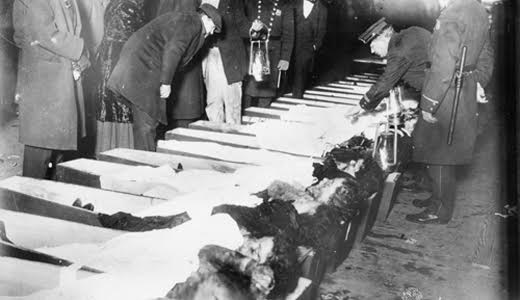
For over a hundred years, New Yorkers have assembled near Washington Square Park to commemorate the anniversary of the Triangle Shirtwaist Factory fire, one of the most heinous actions in United States labor history.
On Wednesday, March 23, many workers and members of various unions including SEIU, RWDSU, AFSCME, and others gathered to mark the 105th anniversary of the tragic event that highlighted an egregious lack of legal safety protections for workers at the beginning of the 20th century. This year, the crowds also convened to celebrate the coming installment of a permanent art display at the historic site to forever bring attention to the fire that ended the lives of 146 women working under inhumane conditions.
Family members of the deceased were also present, and many in the crowd carried poles dressed in garb that would have been traditional for women in the early 1900s, inscribed with the individual names of the workers who died in the fire. Vincent Alvarez of the New York City Central Labor Council spoke of the continued need to stand with workers for safety in the workplace, as well as many public officials. Members of the UFT, New York City’s teacher’s union, talked about the importance of workplace safety standards to public education.
The Triangle Shirtwaist Company was a clothing-making sweatshop operating in Manhattan’s downtown area that employed mainly Jewish and immigrant women for insufferably long hours and poverty wages. Most of these women were quite young, some no more than 17 years old. Many women brought their children into the factory’s “kindergarten,” where the young ones would snip thread. Working conditions in the factory were unsanitary and dangerous. Scraps of flammable material were heaped in wicker baskets and oil slicked the floors.
The factory’s owners padlocked the doors to the stairwell out of fear of employee theft, and a pile of boxes crowded the exit from the cluttered workspace. When fire broke out in the eighth floor of the building near closing time on March 25, 1911, the women were unable to escape. The fire escapes did not reach to the ground, were rusty, and collapsed. The fire department ladders were only able to reach to the sixth floor, two floors below the level of the workers. Many jumped to their deaths, as safety nets were insufficient to protect them from the fall.
These unsafe conditions were not uncharacteristic of other sweatshops. In fact, due to the activities of radical organizer Clara Lemlich, the situation at the Triangle Shirtwaist Company was somewhat better than in other similar factories. Lemlich had led 400 of her coworkers in a strike two years earlier which ultimately culminated in a general strike where 20,000 walked off their jobs, demanding a 20 percent raise, a 52-hour work week, overtime pay, collective bargaining rights, and the legal enforcement of workplace health and safety standards. Despite these important mobilizations, the women at the Shirtwaist factory remained non-unionized. As immigrants, many of them lacked the legal protections that could have made unionizing a less risky enterprise.
Nonetheless, the disastrous consequences of unprotected workers caught in a firetrap, combined with the increase in union activity that followed, brought attention to widespread abuses. This resulted in the establishment of many labor protections on a national scale in the area of health and safety laws, fire code improvement, and the introduction of workers compensation laws.
We yet find ourselves in an era where far-right social elements are attacking and undermining union rights through a variety of means, including “right-to-work” laws, and where union busting activities remain prevalent on the part of the bosses. It is as important now as ever to bring attention to the exploitive conditions under which many have worked and continue to work, and the ways in which they are fighting back. The particular challenges which continue to face immigrant workers also cannot be erased. While a monument is being raised to the memory of immigrant workers who unnecessarily met their deaths due to the callous greed of their employers, 105 years later and one block away, immigrant workers at Bröd Kitchen continue to face discrimination, low wages, and union busting activity.
Unions remain the best form of protection that workers can have, which is what makes the efforts to undermine their strength particularly pernicious. As the strike leader Rosa Safran, who survived the Shirtwaist Factory Fire said, “If the union had won, we would have been safe. Two of our demands were for adequate fire escapes and for open doors from the factories to the street. But the bosses defeated us and so we didn’t get the open doors or the better fire escapes. So our friends are dead.”
Although many advances have been made through the organizing efforts of those who have gone before, the struggle continues. The #Fightfor15 and a Union movement is an essential one for countless low wage workers who are disproportionately women of color and immigrant workers. An immigrant worker employed in the nail salon industry in New York City spoke of the super-exploitation she and her co-workers experience, working 11-hour days for as little as $45.
People’s World had a chance to speak at the rally with Rachel Forest, director of the Retail Action Project (RAP), which is a worker center initiative of RWDSU. Forest spoke of the ways in which the strength of labor has been eroded in recent decades and how maintaining the legacy of the labor movement is essential for helping young workers understand where their power comes from. “We think for our union, and for RAP as a worker center, that legacies like this are crucial [to] people feeling inspired and understanding what it means to stand up and organize and really demand that their lives as workers, not only in this country, but around the world, deserve and need respect – in order to honor the planet and future generations and [to] ensure that people can live in a world with real justice.”
The art display soon to be installed at the site of one of labor history’s most historic moments will engage those passing by with the history of the fire and the names of the workers who died in it. The text will be engraved on a mirrored panel running around the corner of the building. Those from afar will be able to observe steel panels rising up to the eighth floor where the fire started.
The program for the commemorative event on Mar. 23 included the raising of the fire ladder, which highlighted its inability to reach the workers, and a recitation of the names and ages of the young women who died. The history of people’s struggles for justice and fairness, and the forces they encounter in this fight, must remain firmly in the mind of the public. These movements must find a mass base of support for a historically based struggle capable of establishing a more just and equitable world.
Photo: Victims of Triangle Shirtwaist Factory fire in coffins. | Series: Photographs from the Depression and World War II, 1870-2004/Collection: Franklin D. Roosevelt Library Photographs, 1870-2004










